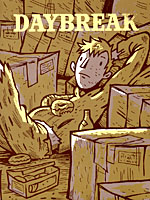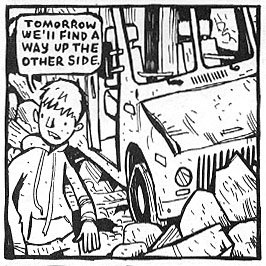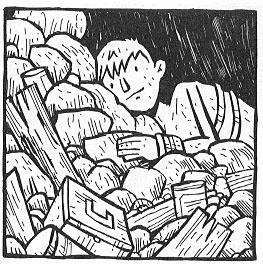 By Brian Ralph
By Brian Ralph
48 pages, black and white
Published by Bodega Distribution
When is a gimmick not a gimmick? That’s a question I quickly found myself contemplating as I read Brian Ralph’s series Daybreak. Taking a rarely used storytelling device of setting the story in the second person (and thus making the reader part of the story), it’s easy to write off the decision as an attention-grabbing stunt, or just an attempt to be different. The more I read of Daybreak, though, the more convinced I am that Ralph’s using it as part of a plan to tell a very different story of survival. And when you look at it that way, it works remarkably well.
The world is in ruins, destroyed by masses of zombie-like creatures that continue to rampage across the landscape. You are trying to survive, having just encountered a one-armed boy who knows the lay of the land. Between the killing beings and fellow humans, though, there is almost nowhere safe to hide these days. Will you live to see another day?
 Brian Ralph’s comics often show a love for one of two settings—underground, enclosed spaces (Cave-In) or post-apocalyptic wastelands (Crum Bums, Climbing Out). It’s apt, then, that Daybreak finally truly combines the two. It’s a curious creature, placing the reader into the center of the story as a mute character in the narrative. It gives the (still unnamed) one-armed boy someone to talk and explain things to, but more than that, it works surprisingly well in providing a real sense of menace in the story. Ralph actually makes the reader feel someone responsible for the situations that the characters are put in, and there’s an added incentive to see a character survive—if “you” don’t make it to the next scene, the story will be over.
Brian Ralph’s comics often show a love for one of two settings—underground, enclosed spaces (Cave-In) or post-apocalyptic wastelands (Crum Bums, Climbing Out). It’s apt, then, that Daybreak finally truly combines the two. It’s a curious creature, placing the reader into the center of the story as a mute character in the narrative. It gives the (still unnamed) one-armed boy someone to talk and explain things to, but more than that, it works surprisingly well in providing a real sense of menace in the story. Ralph actually makes the reader feel someone responsible for the situations that the characters are put in, and there’s an added incentive to see a character survive—if “you” don’t make it to the next scene, the story will be over.
The story itself is a curious one, in that there’s no immediate goal or endpoint aside from the most basic one of survival. That’s actually both good and bad, because for people looking for some sort of definitive progress being made, they’ll be out of luck. On the other hand, its open-ended nature gives Ralph the freedom to move the reader and companions from one interesting place to another. The second volume (or as the spine calls it, episode) of Daybreak shifts the scenery into new intriguing places, and also gives a little more of a glimpse into what the rest of the world is looking like and how other people are managing to survive. With a cliffhanger that plays into the special storytelling of Daybreak, the second volume not only shows how well Ralph is working with this format but left me dying for a third installment.
 I really like Ralph’s art in Daybreak; he’s always been well-suited to a strong level of detail in his backgrounds, drawing individual cobblestones, rocks, and other pieces of debris over and over again. The disaster-zone landscape is perfect for just that, collapsed buildings and broken possessions littering the panels. It’s this sort of unraveled world that is Ralph’s strength, from the ratty bandage covering the one-armed character’s stump to the jumble of pastry boxes that dominate a room. Even rain scenes come across as wonderfully oppressive and gloomy, the reader almost available to feel each individual rain drop that Ralph draws.
I really like Ralph’s art in Daybreak; he’s always been well-suited to a strong level of detail in his backgrounds, drawing individual cobblestones, rocks, and other pieces of debris over and over again. The disaster-zone landscape is perfect for just that, collapsed buildings and broken possessions littering the panels. It’s this sort of unraveled world that is Ralph’s strength, from the ratty bandage covering the one-armed character’s stump to the jumble of pastry boxes that dominate a room. Even rain scenes come across as wonderfully oppressive and gloomy, the reader almost available to feel each individual rain drop that Ralph draws.
In a handsome book format, Daybreak is the sort of book for which I’m able to appreciate it both for an admiration of craft as well as just fun as a reader. It’s a sharp series and with two installments now out, all I can hope is that we’ll get more books faster than at an annual level. This is a clever, enjoyable little series, and it’s great to get Ralph’s work on a regular basis. Highly recommended, without a doubt.
Purchase Links:
